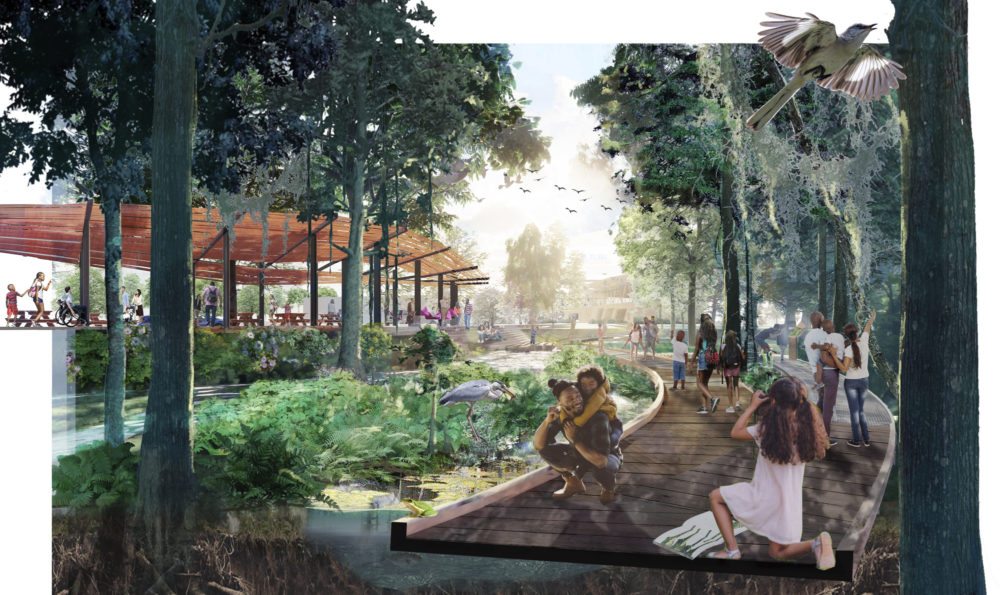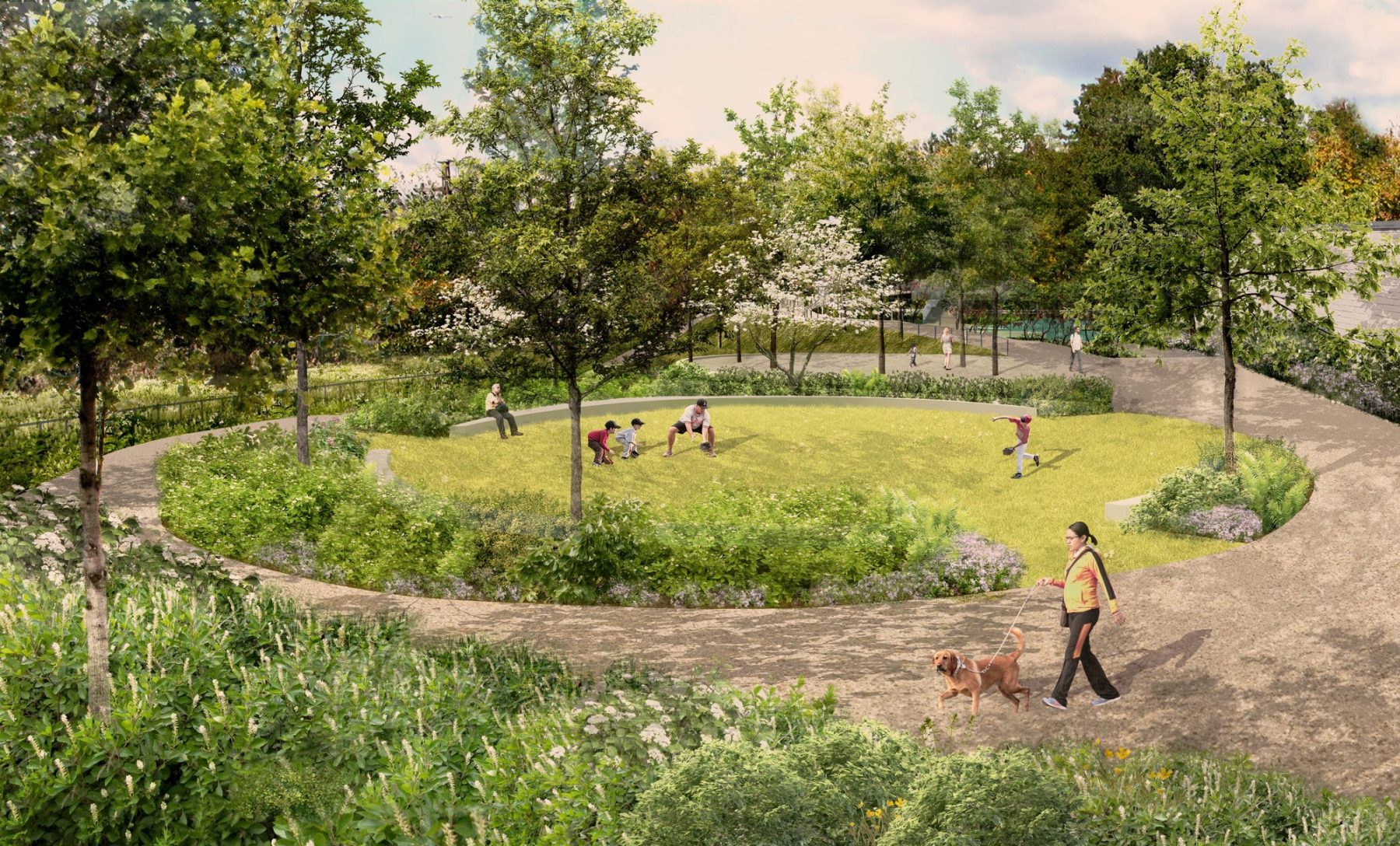
Greenwood Community Park Master Plan and Implementation
Baton Rouge, LA
 Sasaki
Sasaki

Across the United States, communities are facing the challenges of aging infrastructure, congestion, traffic pollution, and disconnected neighborhoods.
These challenges disproportionately impact poor, historically Black, and other disadvantaged communities. To address these issues, the United States Department of Transportation launched the Reconnecting Communities and Neighborhoods Grant Program, aimed at revitalizing urban areas, improving mobility, addressing environmental and climate justice, and repairing disadvantaged communities that have historically been victims of infrastructural redlining.
Legislation like the Inflation Reduction Act and the Bipartisan Infrastructure Law represent some of the biggest federal investment in infrastructure, the environment, and climate resilience in recent history. Funding from these legislations has supported programs such as Reconnecting Communities and Neighborhoods, representing a once-in-a-generation funding opportunity for cities that are looking to undergo a just transition to a greener, more prosperous, and more equitable future.
These programs target projects that are not just about repurposing and revitalizing infrastructure; rather, they seek to catalyze a wider set of benefits: redressing the historical harm that urban highways have had on disadvantaged communities, creating climate infrastructure and economic development opportunities, as well as making space for social gathering and safe, sustainable mobility.
These multi-faceted projects require a truly holistic perspective on urban infrastructure and public realm that brings together expertise across planning, urban design, landscape architecture, economic development, civil engineering, and community engagement. These are exactly the type of integrated, holistic efforts that Sasaki excels at. In recent months, Sasaki has successfully helped communities develop infrastructure transformation projects, and in turn, both connect cities and successfully seek federal funding for them.
In New York, Phase Two of the city’s QueensWay project has secured over $100 million in federal funding, NYC’s largest grant award win in over a decade. Earmarked to further develop the greenway being built on a vacant corridor of the former LIRR Rockaway Beach Branch, this funding will connect to Sasaki’s design for Phase One of the QueensWay — the Metropolitan Hub (Met Hub).
Working together with engineers Techno Consult and client New York City Economic Development Corporation (NYCEDC), Sasaki’s design for Phase One will transform a vacant parcel of abandoned railroad tracks into a beautiful, resilient, and safe pedestrian corridor. Together, Phase One and Two will create a greenway extension to Forest Park and add vibrant parks and outdoor amenities to neighborhoods across Queens.

The QueensWay transforms a track of the Long Island Rail Road into a new linear public park for Queens.
NYC DOT and NYSDOT, together in a partnership, sought a Neighborhood Access and Equity Grant (NAE) Community Planning Grant. The proposed project, BQE Connects, will advance the Brooklyn Queens Expressway (BQE) North and South Corridor Vision. Sasaki’s design for the BQ Green reconnects neighborhoods divided by the construction of the BQE and reduces many of the negative environmental, economic and social impacts of the highway artery. Notably, the creation of a 3.5 acre green space would improve air quality in a park-poor area of New York.
BQE Connects will identify a concept proposal or set of concept proposals to improve access and reduce environmental, social, and economic burdens for disadvantaged communities, and advance those proposals in a minimum of two communities/areas within the BQE North and South extents. NAE funds will help develop evaluation criteria to select concept proposals, and then complete conceptual design for said proposals, as well as fund community engagement throughout the project.

BQ Green is a design proposal as part of the BQE Connects plan.
Once well-connected to the natural beauty of the Pacific Ocean, Los Angeles’ Wilmington neighborhood had slowly been separated from the coast by the expansion of the Port of Los Angeles—a major maritime industry powerhouse. As the busiest container port in North America, and a major source of economic vitality for the neighborhood and region, the port committed to enhancing public access to the waterfront for the local harbor community, in order to expand its role as both key attraction and economic driver for the area.


Sasaki designed the Wilmington Waterfront Promenade to bring the community back to the water. Now, a future land-bridge connection will carry Angelenos and visitors over the industrial port sites to arrive in the space of the promenade—a grand entrance, opening to a sweeping view of LA harbor from the top of a sculpted landform and public park. The Port of Los Angeles was one of the Reconnecting Communities Grant awards for the pedestrian bridge over two mainline freight tracks which connects the Wilmington community with the waterfront.
In Boston, Sasaki has been supporting Harvard University with their land planning initiatives for over the past five years on projects like the Enterprise Research Campus Framework Plan, and now their Institutional Master Plan process for their campus in Allston. As part of the Reconnecting Communities program, $335 million was secured in funding for the Allston I-90 Multimodal Project to reconnect communities in Allston and Brighton that were unjustly severed from Boston’s downtown and the Charles River.
The project will see the section of the I-90 Interchange west of the Charles River be realigned to the south. An urban-style, split diamond interchange will replace ramps, and an east-west collector-distributor with roadways/ramps will transition to a series of new north-south urban streets and signalized intersections. The Project will add 4.5 acres of park land and provide extensive bicycle and pedestrian infrastructure that prioritizes safety. West Station will be constructed at the site of a former rail yard and will offer four station tracks, three platforms and a new transitway and a project Phase II will incorporate rail yard layover.

Allston is one of the most diverse neighborhoods within the City of Boston, Massachusetts.
At 660-acres, Greenwood Community Park is the largest park in East Baton Rouge (EBR) Parish. In 2018, Sasaki was hired to reimagine the future of Greenwood Park and lead a community process that worked in collaboration with the Baton Rouge Zoo—which underwent a simultaneous master planning process led by Torre Design Consortium, Ltd. Then, in late 2019, the Sasaki and Torre team were asked to lead Phase 1 design implementation of the plan.
The new Greenwood Park is designed to serve as a place to both get away and come together. The balanced nature-based and active program elements are stitched together by a network of multi-modal trails that connect people to this place. Greenwood Park is directly adjacent to another Reconnecting Communities grant award; Improvements to Thomas Road. This project will implement complete street principles on Thomas Road in Baton Rouge, Baker, and East Baton Rouge Parish.

Sasaki was hired to reimagine the future of Greenwood Park in Baton Rouge.
The planned work includes safety improvements, drainage improvements, and the creation of a new multi-use path to connect local neighborhoods to public transportation, parks, services, retail, and job opportunities. The improvements offer an opportunity to address multiple challenges including equity, environmental justice, access, community engagement, climate, environment and economic opportunity
Today, Sasaki is actively involved in projects across the United States in which we are helping communities navigate various stages of seeking federal and state funding. To us, these projects are deeply meaningful. They exemplify our value of aligning high-quality place-making with equity and environmental justice. They bring the best of our expertise, from planning to landscape architecture and community development, together. Most importantly, they showcase how we serve as partners to our communities, helping them bring big, ambitious visions from initial strategy and funding through design and implementation.